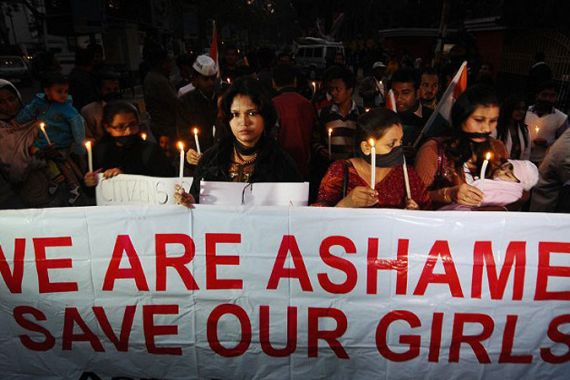Ending India’s rape culture
Women and men who support freedom of movement and safety from sex crimes are being forced to “refight that battle”.

The crime seems incomprehensible. A 23-year-old physiotherapy student is dead, 12 days after having been raped for more than an hour by six men in a bus travelling on main roads in the Indian capital. Her internal injuries from the iron rod that her attackers used were so severe that doctors had to remove her intestines in their effort to save her life.
Indians, it seems, have had enough. Dozens of large and increasingly angry demonstrations have been held to demand that the government ensure women’s security and stop treating rapists with impunity. While the authorities have sought to quell the protests – cordoning off central New Delhi and subjecting the rest of the city to traffic restrictions – violence has escalated. After a policeman died, live ammunition was fired into the crowds – killing a journalist, Bwizamani Singh, and provoking a rebuke from Reporters without Borders.
It is not simply the high rate of rape in India that is driving the protests’ virulence. In a passionate speech, Kavita Krishnan, Secretary of the All India Progressive Women’s Association, spoke to the deeper issue behind the protests: the blame-the-victim culture in India around sex crimes. She notes that government and police officials recently insisted that most rapists cannot be prosecuted in India, because, as one official put it, they are known to the women attacked. Other officials have publicly suggested that victims themselves are “asking for it” by their use of freedom of movement.
This return to pre-feminist discourse is not confined to India. Italy is having a similar debate about whether women’s clothes and behaviour invite rape. Even in Sweden, activists complain, rapes in which the men know their assailants go unprosecuted, because the victims are not seen as “good girls”.
|
India protesters pressure government on rape |
Krishnan assailed the fact that the conviction rate for rape prosecutions in India has fallen from 46 percent in 1971 to just 26 percent today (which, it should be noted, is higher than the conviction rates in the United Kingdom, Sweden and the United States). Indeed, the fact that most rapes are committed by men who are known to the victim should “only make it easier to apprehend the rapist”. Instead, women who go to the police are urged not to file a complaint. “Strange people will begin to assemble at the station out of nowhere to ‘explain’ to you” why that advice is correct.
The problem, Krishnan points out, starts at the top. In the midst of the protests, Delhi Police Commissioner Neeraj Kumar sparked further outrage by suggesting that women carry chilli powder to deter would-be rapists. And, at a press conference, he said that women should not roam around without male escorts. Otherwise, whatever happens to them is their own fault.
Now, with the protests continuing in the aftermath of the victim’s death, officials are emphasising the need for measures to guarantee the “safety and security” of women. But, as Krishnan notes, “the word ‘safety’ with regard to women has been used far too much”. Indian women have heard it all their lives. “It means,” she says, “You behave yourself. You get back into the house. You don’t dress in a particular way. Do not live by your freedom…. A whole range of patriarchal laws and institutions tell us what to do in the guise of keeping us ‘safe’.”
The six men accused of the bus attack have been arrested and charged with murder and the government has ordered an inquiry into how rape cases are handled. But the government’s critics remain skeptical of official intentions, noting that only 600 rapes per year are reported in the capital, despite the thousands that are estimated to occur annually.
The deeper truth underlying the protests can be found on blogs, where young Indian men and women bemoan the fact that travel guidebooks routinely warn women about pervasive sexual harassment in India and advise them to move around in groups. Movies, religion, music and women themselves are all blamed for male sexual violence against women, but rapists are not held responsible. A “male-cosseting culture,” as one blogger put it, in turn supports a rape culture.
The connection between rape, male privilege and female sexual vilification was one of the key insights of feminists in the 1970s – an insight that they thought had been successfully applied to cultural debate about rape and to law. In India – as in Italy, Sweden and around the world – women and men who support freedom of movement and safety from sex crimes are being forced to refight that battle. One hopes that the protests in India will inspire the West to emulate the protesters’ lack of complacency.
In the developing world, women are in special jeopardy. Their embrace of autonomy and mobility risks putting them in conflict with a law-enforcement establishment and media that still view women through a pre-feminist lens: “good girls” who stay at home should not be raped, while “bad girls” who stake a claim to public space are fair game.
Naomi Wolf is a political activist and social critic whose most recent book is Vagina: A New Biography.
A version of this article first appeared on Project Syndicate.
